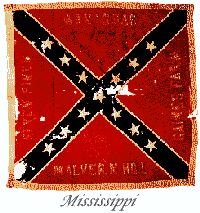In this county is a large Confederate
cemetery, located on ground belonging to the University of Mississippi,
about one-third of a mile southwest of the University buildings. In it
are buried between 700 and 800 soldiers, most of whom died in the University
hospital of wounds and sickness. Soon after the close of the war the ladies
of Oxford and the University raised funds and enclosed this cemetery with
a wooden fence, but it was destroyed by forest fires. This was repeated
a number of times; finally the Lafayette County Camp, No. 752, United Confederate
Veterans undertook the task of raising funds for an iron fence. In this
their efforts were nobly seconded by the ladies. The result was the erection
of a neat and strong iron fence which now encloses it.
In addition to their efforts to raise money
for enclosing the cemetery, the ladies worked most commendably for ten
or twelve years after the war for funds for a soldiers’ memorial. These
funds first collected they unfortunately lost by a bank failure. They renewed
their efforts, in which were conspicuous Mrs. Jennie Rascoe, Miss Helen
Conkey, the Misses Wohleben, Miss Anna Bowen and Miss S. McGehee Isom,
Miss Sallie McKie, now Mrs. Murry. The class of 1877 of the University
made a contribution to this fund which was to be a class memorial as well
as an aid to the soldier’s memorial. The money thus raised was used by
Chancellor Edward Mayes, LL.D., in the construction of a large memorial
glass window in the library building of the University in honor of the
“Confederate Grays,” a gallant company formed of the students of the University
in 1861, whose valor and devotion made glorious many a battlefield.
In 1892, at the call of R. W. Jones, some of
the ladies of the vicinity met in the parlor of Mrs. Jennie Rascoe and
by his advice organized a Confederate Memorial Association, the distinct
object of which was to solicit and raise money for a soldiers’ monument.
Mrs. Bem Price was elected president, Mrs. R. W. Jones vice-president,
Mrs. J. N. Standifer secretary, and Mrs. Rascoe treasurer. After pursuing
this work for some time the organization was changed into the Albert Sidney
Johnston Chapter of the United Daughters of the Confederacy. By this organization
the work has been prosecuted. The officers were: Mrs. Bem Price, President;
Mrs. R. W. Jones, Vice-President; Mrs. J. S. Hudson, Secretary; Mrs. J.
E. Neilson, Treasurer; Mrs. J. G. Durpree, Historian. Owing to family affliction
Mrs. Price resigned, and Mrs. Jones was elected president, and Mrs. E.
0. Davidson and Miss Eugenia Trigg, vice-presidents. Although the community,
as a whole, has not encouraged these ladies as generously as would be expected
from the sacredness of the cause and the prominence of the locality, some
citizens have shown a liberal spirit, and the ladies hope at an early day
to be able to erect an imposing marble or granite shaft.
Decoration Day has been observed annually for
a long time. It is an interesting historical fact in this connection that
in 1892 there seemed to be apathy in preparing for this observance; when
a student of the University, W. F. Nelson, of Copiah County, came to the
rescue, raised funds, had the graves cleaned off and arranged for a decoration,
which was conducted with lively interest. Speeches were delivered by Major
R. W. Jones and Capt. Charles B. Howry, and unusual enthusiasm was aroused.
Decoration Day is regularly observed each year. A procession is formed
in town, headed by the First Regiment Band, followed by the school children,
bearing flowers, and the Confederate veterans. They march to the cemetery
and scatter the flowers. An address is then delivered by some chosen speaker,
and Southern war songs are sung.
It is unfortunate that the boards which were
placed at the graves of the deceased soldiers were removed, so that now
it is impossible to identify them. The University buildings were long used
as a Confederate hospital; many wounded and sick soldiers from the armies
of Generals A. S. Johnston, Bragg, Price VanDorn, Forrest and perhaps others,
were there given medical treatment. For a long time there was a record
of the names the soldiers buried here; Mrs. Jennie Roscoe is said to
have possessed such a register, but the writer has sought for it in vain.
Dr. Isom was the chief surgeon of this hospital and Dr. A. M. King was
one of the assistant surgeons. The latter has furnished a list of those
who died in his ward, the names, company regiment, state and the disease
of which they died. With the omission of the last item, this list is given
in Appendix C.
Return to Confederate Cemetery Menu
Return to State Table of Contents
Home




